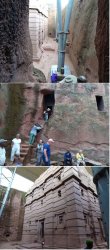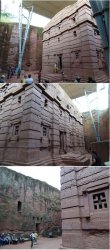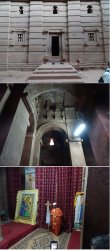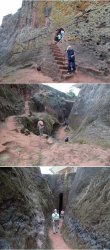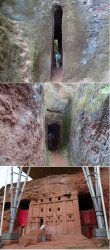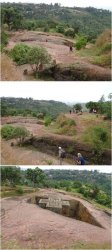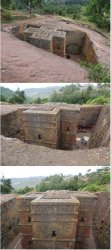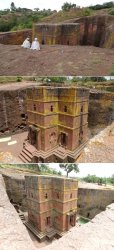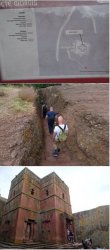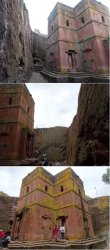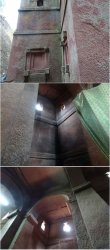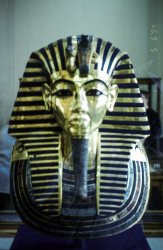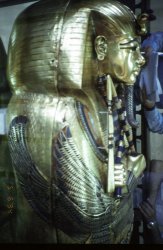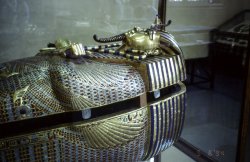You are using an out of date browser. It may not display this or other websites correctly.
You should upgrade or use an alternative browser.
You should upgrade or use an alternative browser.
A North Africa and Middle East ramble
- Thread starter JohnM
- Start date
- Status
- Not open for further replies.
- Joined
- Nov 12, 2012
- Posts
- 31,159
- Qantas
- Platinum
- Virgin
- Platinum
- Star Alliance
- Gold
Alright, alright, I give up! I'm going 
I see a guaranteed and available tour in second half of October and also late Nov/early Dec next year. Which do you think would be better weather-wise? (Exodus' weather tips indicates Nov best for Addis, but in the mountains?
I see a guaranteed and available tour in second half of October and also late Nov/early Dec next year. Which do you think would be better weather-wise? (Exodus' weather tips indicates Nov best for Addis, but in the mountains?
JohnM
Enthusiast
- Joined
- Jun 7, 2006
- Posts
- 11,804
- Qantas
- LT Gold
Alright, alright, I give up! I'm going
I see a guaranteed and available tour in second half of October and also late Nov/early Dec next year. Which do you think would be better weather-wise? (Exodus' weather tips indicates Nov best for Addis, but in the mountains?
I suspected you might check it out
However, here's what LP says:
High season (Jan-Mar): Expect sunny skies and warm days.
Shoulder season (Oct-Dec): The country is green, skies are sunny and there are fewer visitors.
Low season (Apr-Sep): The rainy season in S Ethiopia and scorching temperatures in the lowlands can make travel difficult.
I conclude that either of those tours would be fine. I think you'd probably have it a little drier than me. Not that we had much rain but some of the unmade roads were still sloppy and there were a couple of times I thought we might get stuck.
JohnM
Enthusiast
- Joined
- Jun 7, 2006
- Posts
- 11,804
- Qantas
- LT Gold
Some great photos you have there. Ethiopia is much greener than I would have thought.
I suspect a lot of people may have the same reaction. This tour focussed on the upland historical circuit. There is plenty of desert in the S and E (I'd love to visit those areas!).
JohnM
Enthusiast
- Joined
- Jun 7, 2006
- Posts
- 11,804
- Qantas
- LT Gold
The next day, it was up early for a mule ride up Abune Yosef mountain to visit Ashetan Maryam (St. Mary) monastery. The monastery is not nearly as spectacular as those in Lalibela, but it’s really the mountain scenery from 3150 m that is the main attraction.
Note the cobblestone streets common in Lalibela. It was a Saturday and a major market day, so there was quite a bit of traffic going downhill.
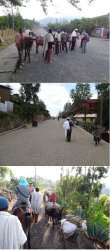
Getting very steep and soon time to dismount and walk to a rest stop on flatter ground. Then it was back on the steeds for a pleasant walk through farmland before facing another section of steep terrain and dismounting for the final walk to the monastery.
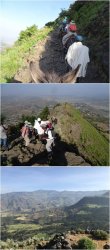
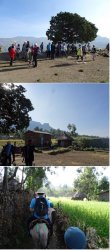
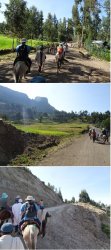
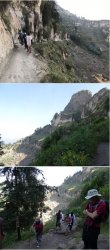
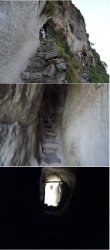
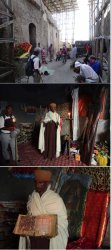
View from near the monastery, including zooming in on the Lalibela market and a coffee stop before re-mounting the donkeys to go back to town.
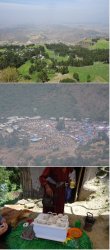
This little dude was keen to lead my donkey.
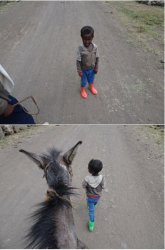
Note the cobblestone streets common in Lalibela. It was a Saturday and a major market day, so there was quite a bit of traffic going downhill.

Getting very steep and soon time to dismount and walk to a rest stop on flatter ground. Then it was back on the steeds for a pleasant walk through farmland before facing another section of steep terrain and dismounting for the final walk to the monastery.






View from near the monastery, including zooming in on the Lalibela market and a coffee stop before re-mounting the donkeys to go back to town.

This little dude was keen to lead my donkey.

JohnM
Enthusiast
- Joined
- Jun 7, 2006
- Posts
- 11,804
- Qantas
- LT Gold
That evening it was dinner at Ben Abeba. It’s an extraordinary restaurant on the top of a hill with sensational views built and operated by a Scottish lady who went to Lalibela as a teacher some time ago, and her Ethiopian business partner. Lovely people.
The name derives from the Scottish Ben which means hill and the Ethiopian abeba which means flower – ‘Hill of Flowers’. It has the most extraordinary Gaudi-esque construction. Not to be missed when in Lalibela and superb at sunset.
As the Lonely Planet says: “Hands-down the coolest restaurant in Ethiopia.” I’d say one of the coolest anywhere.
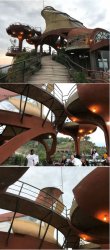
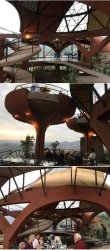
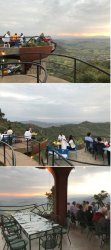
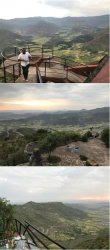
And that brought the sun down on Lalibela and Ethiopia. The next day it was out to LLI for the ET flight back to ADD. Early next morning it was ADD-CAI. Coming up: Egypt.
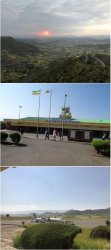
The name derives from the Scottish Ben which means hill and the Ethiopian abeba which means flower – ‘Hill of Flowers’. It has the most extraordinary Gaudi-esque construction. Not to be missed when in Lalibela and superb at sunset.
As the Lonely Planet says: “Hands-down the coolest restaurant in Ethiopia.” I’d say one of the coolest anywhere.




And that brought the sun down on Lalibela and Ethiopia. The next day it was out to LLI for the ET flight back to ADD. Early next morning it was ADD-CAI. Coming up: Egypt.

craven morehead
Established Member
- Joined
- Aug 1, 2008
- Posts
- 2,736
- Qantas
- Platinum
- Virgin
- Gold
That evening it was dinner at Ben Abeba. It’s an extraordinary restaurant on the top of a hill with sensational views built and operated by a Scottish lady who went to Lalibela as a teacher some time ago, and her Ethiopian business partner. Lovely people.
The name derives from the Scottish Ben which means hill and the Ethiopian abeba which means flower – ‘Hill of Flowers’. It has the most extraordinary Gaudi-esque construction. Not to be missed when in Lalibela and superb at sunset.
As the Lonely Planet says: “Hands-down the coolest restaurant in Ethiopia.” I’d say one of the coolest anywhere.
View attachment 112103
Man that is one funky restaurant. Thanks to people like you JohnM I'm getting to see some really cool places. Cheers CM
Read our AFF credit card guides and start earning more points now.
AFF Supporters can remove this and all advertisements
JohnM
Enthusiast
- Joined
- Jun 7, 2006
- Posts
- 11,804
- Qantas
- LT Gold
OK, getting back to this briefly before heading in the morning to the other side of Kalgoorlie for a week.
Time was tight between the end of the Ethiopia trip and the start of the tour in Egypt. Strictly speaking, I should have been in CAI the previous evening to be prepped for a fairly early start the next morning. With a little luck, I thought a very early morning flight ADD-CAI, a fast immigration clearance and bag pickup and a suitably maniacal taxi driver from CAI to my hotel may just get me there in time for tour kickoff and the first port of call – the pyramids a mere 8 km away.
Despite all those things aligning, I got to the hotel about 10 minutes after the group had left. To my chagrin – and later the tour leader’s once he found out – the staff on the desk at that time claimed not to have the tour leader’s phone number. About 1.5 hours later, someone found it and I was soon on my way by taxi to meet the group just as they finished the pyramids and were moving over to the sphinx.
The tour leader promised to get me back to the pyramids on the final day of the tour as I had time to kill, so all was fine. Unfortunately, that day was smoggy compared with the clear first day.
To return things to planned sequence, I’ll combine pics of the pyramids/sphinx visit from the first and last days. The sky will look different because of that.
Firstly, what became immediately apparent in Egypt was that there were few tourists. Numbers are running at about 10% of the pre-revolution peak. Brutal for the economy; sensational for the tourist – I would not want to be in crowds 10x larger. All I can say is that if you have a hankering to visit Egypt (and it is amazing), just do it now. Ignore the latest atrocity – that was on the Sinai, which I was told has virtually shut down as a tourist destination. And, in any event, that was an intra-religious criminal act. Egypt is a safe as houses – but the Chinese are coming…
OK, the pyramids in the smog. Imposing, to say the least, but after the clear day at the beginning it was hard not to feel a little disappointed that I wasn’t seeing them at their best. C’est le vie.
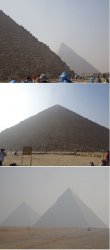
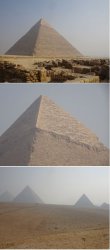
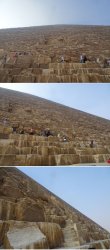
Now from the separate Sphinx area almost two weeks before. The air is a bit nicer… Note the chairs in the top pic. They are for the evening sound and light show (more on that fairly cheesy event later).
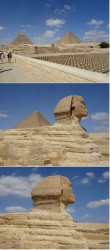
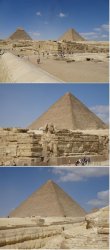
Time was tight between the end of the Ethiopia trip and the start of the tour in Egypt. Strictly speaking, I should have been in CAI the previous evening to be prepped for a fairly early start the next morning. With a little luck, I thought a very early morning flight ADD-CAI, a fast immigration clearance and bag pickup and a suitably maniacal taxi driver from CAI to my hotel may just get me there in time for tour kickoff and the first port of call – the pyramids a mere 8 km away.
Despite all those things aligning, I got to the hotel about 10 minutes after the group had left. To my chagrin – and later the tour leader’s once he found out – the staff on the desk at that time claimed not to have the tour leader’s phone number. About 1.5 hours later, someone found it and I was soon on my way by taxi to meet the group just as they finished the pyramids and were moving over to the sphinx.
The tour leader promised to get me back to the pyramids on the final day of the tour as I had time to kill, so all was fine. Unfortunately, that day was smoggy compared with the clear first day.
To return things to planned sequence, I’ll combine pics of the pyramids/sphinx visit from the first and last days. The sky will look different because of that.
Firstly, what became immediately apparent in Egypt was that there were few tourists. Numbers are running at about 10% of the pre-revolution peak. Brutal for the economy; sensational for the tourist – I would not want to be in crowds 10x larger. All I can say is that if you have a hankering to visit Egypt (and it is amazing), just do it now. Ignore the latest atrocity – that was on the Sinai, which I was told has virtually shut down as a tourist destination. And, in any event, that was an intra-religious criminal act. Egypt is a safe as houses – but the Chinese are coming…
OK, the pyramids in the smog. Imposing, to say the least, but after the clear day at the beginning it was hard not to feel a little disappointed that I wasn’t seeing them at their best. C’est le vie.



Now from the separate Sphinx area almost two weeks before. The air is a bit nicer… Note the chairs in the top pic. They are for the evening sound and light show (more on that fairly cheesy event later).


JohnM
Enthusiast
- Joined
- Jun 7, 2006
- Posts
- 11,804
- Qantas
- LT Gold
A lot of interruptions at present, but getting back to this.
The afternoon was spent at the Egyptian Museum. It’s an old non-airconditioned building and space is tight. Superficially, it can feel a little jumbled inside but there is just so much stuff from a very long period that it can overwhelm. A half-day visit can do no more than skim the surface. The enthusiast could take more time and delve much more deeply.
The key exhibit is, of course, the Tutankhamun Galleries but no photos are permitted.
A massive new museum is under construction out near the pyramids.
I won’t attempt to describe stuff. A few pics will serve to give an idea of the museum for anyone who hasn’t been and is curious.
As you can see, like the whole time in Egypt, crowds were very light. Great for the visitor; not good for the economy. It was a not excessively hot day but I would not like to have been in there with large crowds.
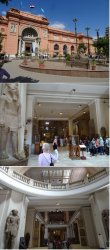
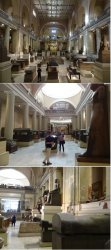
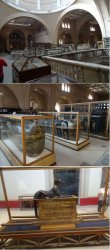
Sunset from the hotel, about 8 km from the pyramids. The next day was driving to Alexandria, passing the pyramids and the new museum under construction.
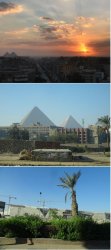
A common sight in this part of Egypt is the pigeon towers. Pigeon is a commonly eaten meat. I’m guessing that people slip in at night while the pigeons are snoozing and grab a few for the pot.
Fort Quaitbey (1480AD) sits on the remains of the legendary Pharos lighthouse, one of the Seven Wonders of the Ancient World, which had been in operation for 17 centuries until being destroyed by an earthquake in the late 14th century. Ancient Alexandria of Cleopatra’s time lies under those boats bobbing on the ocean.
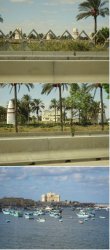
Al Montazah Palace and Gardens, built by the kings in the late 19th and early 20th centuries. Now used for state functions and not open to visitors.
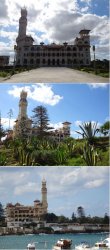
The massive Bibliotheca Alexandrina is a spectacular and high-tech modern ode to the ancient Great Library of Alexandria, renowned as the ultimate archive of ancient knowledge. It is truly one of the great libraries of the world (Home - Bibliotheca Alexandrina).
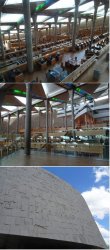
It was then back to Cairo to prepare for that night’s overnight train journey to Aswan.
Before that, a note on security. Egypt has an immense formal and long-established Tourist Police force that monitors all tourist group movements (for security, not repression). The Tourist Police are typically dressed in white uniforms (maybe to appear less intimidating than being dressed in combat gear?), although they are universally armed - typically with Heckler & Koch MP-5 9mm machine pistols or AK-47s.
Airport and train station forecourts are zones restricted to travellers only (brilliant!). Most hotels have a Tourist Police presence and tour guides log their group’s movements (eg. going out for a meal) with them. While ever-present, it wasn’t to me intimidating and it soon just becomes part of the background.
One slight variation occurred in Alexandria when the TP discovered that we had some Americans (two, IIRC) in our group. We then had a plainclothes TP officer join the bus and I believe that a plain car with other officers shadowed us back to Cairo. The plainclothes officer had a H&K MP-5 in a holster bulging slightly on his right hip under his jacket.
Trying to take pics surreptitiously in the train station forecourt…

Waiting for the train. IIRC, the station we used was about one stop from Cairo Central. The train was quite comfortable and certainly clean. A porter in each carriage attended to making up beds and bringing a basic whY-style dinner and breakfast. A perfectly reasonable experience. I slept well, as I always do on planes and trains.
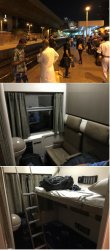

The afternoon was spent at the Egyptian Museum. It’s an old non-airconditioned building and space is tight. Superficially, it can feel a little jumbled inside but there is just so much stuff from a very long period that it can overwhelm. A half-day visit can do no more than skim the surface. The enthusiast could take more time and delve much more deeply.
The key exhibit is, of course, the Tutankhamun Galleries but no photos are permitted.
A massive new museum is under construction out near the pyramids.
I won’t attempt to describe stuff. A few pics will serve to give an idea of the museum for anyone who hasn’t been and is curious.
As you can see, like the whole time in Egypt, crowds were very light. Great for the visitor; not good for the economy. It was a not excessively hot day but I would not like to have been in there with large crowds.



Sunset from the hotel, about 8 km from the pyramids. The next day was driving to Alexandria, passing the pyramids and the new museum under construction.

A common sight in this part of Egypt is the pigeon towers. Pigeon is a commonly eaten meat. I’m guessing that people slip in at night while the pigeons are snoozing and grab a few for the pot.
Fort Quaitbey (1480AD) sits on the remains of the legendary Pharos lighthouse, one of the Seven Wonders of the Ancient World, which had been in operation for 17 centuries until being destroyed by an earthquake in the late 14th century. Ancient Alexandria of Cleopatra’s time lies under those boats bobbing on the ocean.

Al Montazah Palace and Gardens, built by the kings in the late 19th and early 20th centuries. Now used for state functions and not open to visitors.

The massive Bibliotheca Alexandrina is a spectacular and high-tech modern ode to the ancient Great Library of Alexandria, renowned as the ultimate archive of ancient knowledge. It is truly one of the great libraries of the world (Home - Bibliotheca Alexandrina).

It was then back to Cairo to prepare for that night’s overnight train journey to Aswan.
Before that, a note on security. Egypt has an immense formal and long-established Tourist Police force that monitors all tourist group movements (for security, not repression). The Tourist Police are typically dressed in white uniforms (maybe to appear less intimidating than being dressed in combat gear?), although they are universally armed - typically with Heckler & Koch MP-5 9mm machine pistols or AK-47s.
Airport and train station forecourts are zones restricted to travellers only (brilliant!). Most hotels have a Tourist Police presence and tour guides log their group’s movements (eg. going out for a meal) with them. While ever-present, it wasn’t to me intimidating and it soon just becomes part of the background.
One slight variation occurred in Alexandria when the TP discovered that we had some Americans (two, IIRC) in our group. We then had a plainclothes TP officer join the bus and I believe that a plain car with other officers shadowed us back to Cairo. The plainclothes officer had a H&K MP-5 in a holster bulging slightly on his right hip under his jacket.
Trying to take pics surreptitiously in the train station forecourt…

Waiting for the train. IIRC, the station we used was about one stop from Cairo Central. The train was quite comfortable and certainly clean. A porter in each carriage attended to making up beds and bringing a basic whY-style dinner and breakfast. A perfectly reasonable experience. I slept well, as I always do on planes and trains.


JohnM
Enthusiast
- Joined
- Jun 7, 2006
- Posts
- 11,804
- Qantas
- LT Gold
After checking in to the hotel, the first visit was to the Temple of Isis (the goddess of health, marriage and wisdom). It was rescued from the rising waters of the dammed Nile and relocated to Philae Island, a short boat ride away.
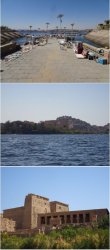
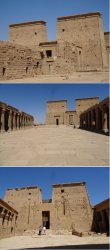
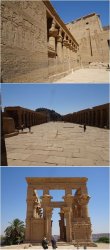
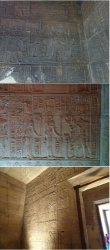
Ubiquitous TP at the temple. You can see how the plainclothes officer could stow the MP-5 in a side-arms holster. View across the Nile from my hotel room. The large building on the island is the Movenpick Hotel.
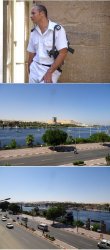
The next day we were scheduled to take the brief flight to Abu Simbel on the upper Nile to view the Ramses II temples that were saved from the rising waters of the Aswan Dam. However, the MS B738 went tech and, after several hours of uncertainty at ASW, was cancelled. We returned to Aswan and checked onto the Nile cruise ship that was to be home for the next three nights.
In the meantime, plan B was being enacted and a very early morning 3h bus ride to Abu Simbel (which is not to be missed) the following day was substituted. All up, it didn’t throw out the schedule too much.
That evening was the obligatory felucca ride on the Nile upstream past the Old Cataract Hotel, where Agatha Christie wrote ‘Death on the Nile’. The tomb of the Aga Khan sits high on a western hill. On the return, we disembarked the felucca at the Old Cataract to scope it out and take in sunset over a wine or two on the terrace…
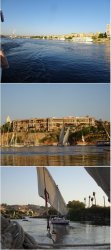
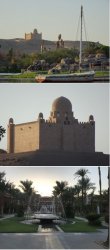
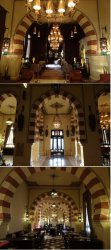
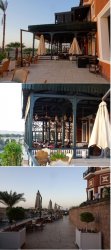
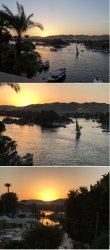




Ubiquitous TP at the temple. You can see how the plainclothes officer could stow the MP-5 in a side-arms holster. View across the Nile from my hotel room. The large building on the island is the Movenpick Hotel.

The next day we were scheduled to take the brief flight to Abu Simbel on the upper Nile to view the Ramses II temples that were saved from the rising waters of the Aswan Dam. However, the MS B738 went tech and, after several hours of uncertainty at ASW, was cancelled. We returned to Aswan and checked onto the Nile cruise ship that was to be home for the next three nights.
In the meantime, plan B was being enacted and a very early morning 3h bus ride to Abu Simbel (which is not to be missed) the following day was substituted. All up, it didn’t throw out the schedule too much.
That evening was the obligatory felucca ride on the Nile upstream past the Old Cataract Hotel, where Agatha Christie wrote ‘Death on the Nile’. The tomb of the Aga Khan sits high on a western hill. On the return, we disembarked the felucca at the Old Cataract to scope it out and take in sunset over a wine or two on the terrace…





- Joined
- Nov 12, 2012
- Posts
- 31,159
- Qantas
- Platinum
- Virgin
- Platinum
- Star Alliance
- Gold
JohnM
Enthusiast
- Joined
- Jun 7, 2006
- Posts
- 11,804
- Qantas
- LT Gold
Next morning and it was through the desert to Abu Simbel on massive Lake Nasser, behind the Aswan High Dam.
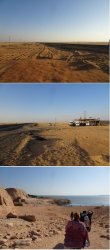
There’s only one thing to see here… - and phwoar!
Photos are not permitted inside the temples.
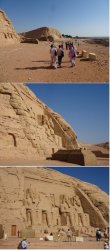
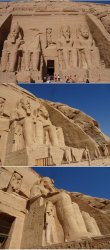
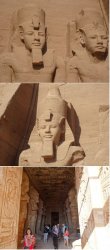
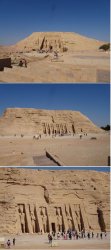
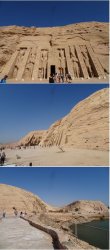
Then it was back to Aswan and onto the cruise boat for the short downstream run to the Kom Ombo Temple. Nile cruise boats are all (and there are a LOT of them – but many are presently tied up or running well below capacity) built to a similar style. They typically carry about 150 pax (we had a maximum of about 40 – which looked quite busy compared with many that went past). The similar size and style enables them to moor multiple boats doubled up and walk through the large central atrium of adjacent ones to get to shore.
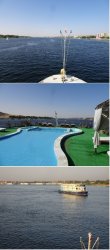
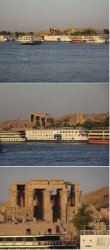
The Temple of Kom Ombo dates to the early 2nd century BC. It’s unique in that it has a mirror-image design, divided down the middle, with either side dedicated to a different set of gods. One side is dedicated to Sobek, the crocodile-headed god of fertility; the other to Horus, the falcon-headed god.
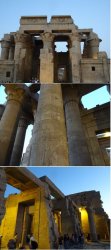
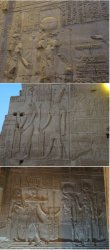

There’s only one thing to see here… - and phwoar!
Photos are not permitted inside the temples.





Then it was back to Aswan and onto the cruise boat for the short downstream run to the Kom Ombo Temple. Nile cruise boats are all (and there are a LOT of them – but many are presently tied up or running well below capacity) built to a similar style. They typically carry about 150 pax (we had a maximum of about 40 – which looked quite busy compared with many that went past). The similar size and style enables them to moor multiple boats doubled up and walk through the large central atrium of adjacent ones to get to shore.


The Temple of Kom Ombo dates to the early 2nd century BC. It’s unique in that it has a mirror-image design, divided down the middle, with either side dedicated to a different set of gods. One side is dedicated to Sobek, the crocodile-headed god of fertility; the other to Horus, the falcon-headed god.


- Joined
- Nov 12, 2012
- Posts
- 31,159
- Qantas
- Platinum
- Virgin
- Platinum
- Star Alliance
- Gold
Moi? Ignore rules! 

 .
.
Can't recall any photo prohibition. I do remember the window in the gallery was open, with only some ordinary-looking bars as security.
Can't recall any photo prohibition. I do remember the window in the gallery was open, with only some ordinary-looking bars as security.
JohnM
Enthusiast
- Joined
- Jun 7, 2006
- Posts
- 11,804
- Qantas
- LT Gold
Moving a little further north on the Nile to Edfu, noted for its well-preserved Temple of Horus. It escaped destruction from Nile floods by a massive mud brick surrounding enclosure. It’s hard to imagine now, with the Nile tamed by the Aswan dams, but the floods must have periodically been enormous in the past. By protecting the temple with a mud brick wall, it could be readily re-built after damaging floods.
The temple is about 2km from the dock and is commonly reached by a shuttle of horse-drawn carriage. There has been some complaint and boycott against what has been perceived as ill-treatment of the horses to the extent that our tour company has made the temple visit optional, where it was once included, but I did not see anything that I would describe as animal cruelty.
Outbound from the dock, plenty of shade at the temple for horses and carriages awaiting returning pax, clip-clopping through Edfu.
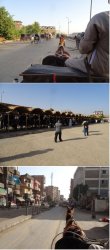
The massive mud-brick wall enclosing the site.
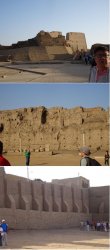
And then the temple. Incredible reliefs, hieroglyphics and, amazingly, a few pieces of original colour remain in high corners.
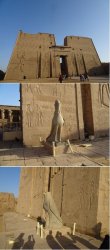
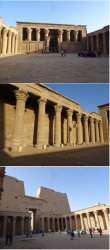
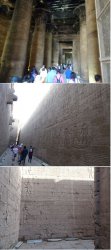
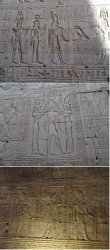
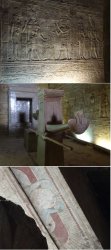
Then back to the boat for the pleasant Sunday cruise approx. 50 km to Luxor and joining the throng of boats doing a similar thing. Going through a lock and the rowing-boat merchants. Then arriving at Luxor in the late afternoon.
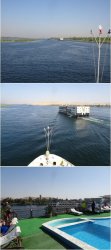
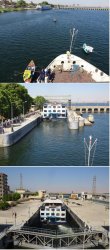
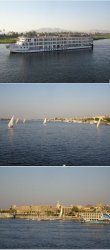
The temple is about 2km from the dock and is commonly reached by a shuttle of horse-drawn carriage. There has been some complaint and boycott against what has been perceived as ill-treatment of the horses to the extent that our tour company has made the temple visit optional, where it was once included, but I did not see anything that I would describe as animal cruelty.
Outbound from the dock, plenty of shade at the temple for horses and carriages awaiting returning pax, clip-clopping through Edfu.

The massive mud-brick wall enclosing the site.

And then the temple. Incredible reliefs, hieroglyphics and, amazingly, a few pieces of original colour remain in high corners.





Then back to the boat for the pleasant Sunday cruise approx. 50 km to Luxor and joining the throng of boats doing a similar thing. Going through a lock and the rowing-boat merchants. Then arriving at Luxor in the late afternoon.



JohnM
Enthusiast
- Joined
- Jun 7, 2006
- Posts
- 11,804
- Qantas
- LT Gold
Luxor (ancient Thebes) is known as the world’s greatest open-air museum, and is a well-presented city. Luxor Temple, largely built around 1400-1200 BC, provides a picturesque backdrop to the dock and it is a short stroll to the entrance on the other side. The larger temple complex of Karnak is a little further away on the same east bank, while the Valley of the Kings is a vast site in the hills of the west bank.
We’re here for three nights – staying on the boat after visiting Luxor Temple on the evening of arrival and transferring to a hotel and having the following two full days to visit Karnak and Valley of the Kings, respectively.
The horse-drawn carriages are common and of a higher standard than at Edfu. Being in the complex as the sun set and the lights came on gave interesting effects.
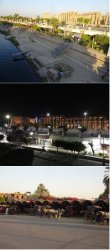
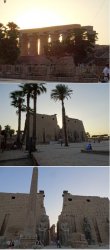
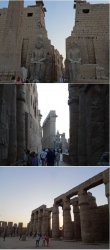
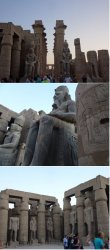
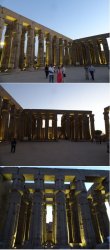
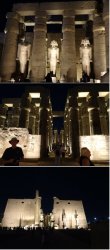
Hard to capture at night, the Luxor Temple end of the Avenue of the Sphinxes which stretches 3 km northwards to Karnak. A higher view, but still only a small section, from an upstairs restaurant two nights later.
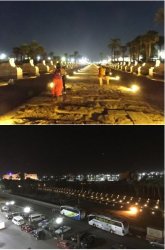
After returning to the boat for dinner, I took a stroll along the riverfront on a balmy evening to the Winter Palace, a famed Egyptian historical Victorian-era hotel. The balcony overlooking the main foyer is the place where Howard Carter announced the discovery of Tut’s tomb. They make a quite reasonable margarita - or two...
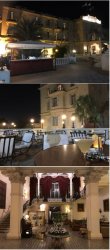
We’re here for three nights – staying on the boat after visiting Luxor Temple on the evening of arrival and transferring to a hotel and having the following two full days to visit Karnak and Valley of the Kings, respectively.
The horse-drawn carriages are common and of a higher standard than at Edfu. Being in the complex as the sun set and the lights came on gave interesting effects.






Hard to capture at night, the Luxor Temple end of the Avenue of the Sphinxes which stretches 3 km northwards to Karnak. A higher view, but still only a small section, from an upstairs restaurant two nights later.

After returning to the boat for dinner, I took a stroll along the riverfront on a balmy evening to the Winter Palace, a famed Egyptian historical Victorian-era hotel. The balcony overlooking the main foyer is the place where Howard Carter announced the discovery of Tut’s tomb. They make a quite reasonable margarita - or two...

- Status
- Not open for further replies.
Become an AFF member!
Join Australian Frequent Flyer (AFF) for free and unlock insider tips, exclusive deals, and global meetups with 65,000+ frequent flyers.AFF members can also access our Frequent Flyer Training courses, and upgrade to Fast-track your way to expert traveller status and unlock even more exclusive discounts!

AFF forum abbreviations
Wondering about Y, J or any of the other abbreviations used on our forum?Check out our guide to common AFF acronyms & abbreviations.
Recent Posts
-
-
Free 2 General Lounge Invitations expiring January 12th 2026
- Latest: CorporateFlyerMEL
-







